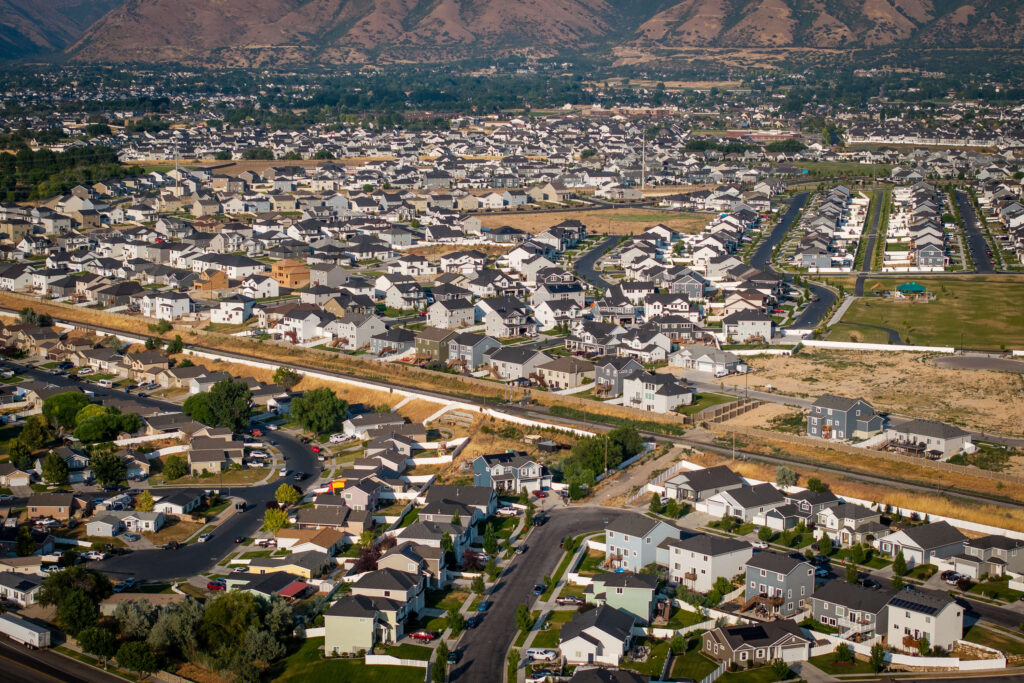A residential area in Spanish Fork is pictured on Tuesday, July 16, 2024. (Photo by Spenser Heaps for Utah News Dispatch)
As Utah’s leaders continue to grapple with the complex question of how to lower the state’s skyward housing costs, a panel on Thursday focused on one piece of the puzzle: design.
As the price tag for homes have trended upward, so has their footprint in both square footage and lot size, according to data from the University of Utah’s Kem C. Gardner Policy Institute, which hosted the panel discussion at the Thomas S. Monson Center in Salt Lake City.
Strikingly, the average home size in Utah has typically ranged around 3,000 square feet in recent years — and in the past 10 years it’s been closer to 4,000 square feet, Moira Dillow, a Kem C. Gardner Institute housing, construction and real estate analyst said during a presentation headlining the panel.
(Courtesy of the Kem C. Gardner Policy Institute)
That may make it “scary” or “daunting” to design smaller homes in Utah, Dillow said, but compact designs could be a key way to lower prices. Especially considering construction costs have also surged — by roughly 30% since 2019, after the COVID-19 pandemic spurred a housing market frenzy.
Affordable starter homes are now rarities, something the Utah Legislature earlier this year tried to tackle by giving cities more tools to leverage financing to encourage private developers to build owner-occupied, single family homes at lower prices. That experiment has only just begun.
In addition to exploring policy angles, housing experts who sat on Thursday’s panel urged local leaders to bring architects with innovative ideas on how to lower the cost of housing early on in the planning process — and not as an afterthought. The panel’s members included:
Steve Waldrip, Utah Gov. Spencer Cox’s senior adviser for housing strategy and innovation;
Jason Wheeler, executive director of ASSIST Inc. Community Design Center, a nonprofit founded by the U.’s Graduate School of Architecture and the Utah Society of the American Institute of Architects;
Maria Sykes, executive director of Epicenter, a nonprofit based in rural Green River that uses design to build more affordable housing.
“While housing affordability remains a critical issue, the conversation often centers around financing, the cost of inputs, labor, supply, public policies,” said Natalie Gochnour, the institute’s executive director, who moderated the panel, challenging its participants to address the housing crisis from another angle. “It seems like we don’t talk about design enough.”
Waldrip acknowledged design is often a “forgotten part of the conversation.”
(Courtesy of the Kem C. Gardner Policy Institute)
“So I’m really grateful that we have thoughtful design partners who can sort of break out of that mold and say what we ought to be doing better,” Waldrip said. “And I think that’s going to be a key component going forward.”
Dillow’s presentation showcased a range of housing types — basement apartments, duplexes or four- or six-unit plexes, cottage clusters, attached or detached accessory dwelling units. Basically anything that could fit on a single-family-sized lot but could house more than one family.
“The data shows that smaller lots and smaller homes create more affordable housing,” she said. “But just because it’s affordable doesn’t mean placemaking has to be sacrificed.”
But it’s easier said than done to challenge what Utahns typically think of when a developer requests a higher-density development. To pave the way for more of these projects, city councils that need to give these types of projects zoning approval often face pushback from neighbors who are fearful that increased density will lead to increased traffic, crime, lower property values, and more.
When Gochnour asked panelists how to address negative public perceptions of increased density, Waldrip acknowledged “density is a four-letter word, no matter how you spell it in Utah,” and yet he said data has shown increased density actually “enhances” property values. But local leaders have plenty of work to do to challenge stereotypes and fear about new types of housing construction.
Especially along the Wasatch Front, where the vast majority of Utah’s population lives, Waldrip said “we have to recognize that we’re going to have to do some verticality, and we’re going to have to do some missing middle, and we’re going to have to do some things that are historically not done here.”
Waldrip harkened back decades, when homes in Utah were smaller, maybe 1,400 square feet instead of 4,000 square feet — and the kids raised in those types of homes actually turned out OK.
“They didn’t die,” he said, prompting laughs from the crowd. “They’re good humans.” And yet today, somehow there’s now an expectation of huge homes and large bedrooms, “and that’s been a huge shift in our mentality.”
Wheeler said it’s ironic that “as Americans, we love to go Europe on vacation, we take all of these photos and think it’s so beautiful, these dense, small towns,” where communities are more walkable. “And then we come home and drive to the big box stores, and we reminisce about how good our vacation was.”
(Courtesy of the Kem C. Gardner Policy Institute)
“We can have that here, you know,” Wheeler said. “We really could have that kind of life here if we’re just willing to embrace it from a design standpoint.”
But that would require courage from local leaders and planning commissions. When Gochnour asked what advice he’d give local leaders facing NIMBYism on higher density or new types of housing projects, Waldrip said to “punch back” and challenge the fears.
All three of the panelists, however, also urged local leaders to get architects involved early on in the planning process and create a “framework” so designers can help drive the vision.
“Typically it’s the developer driving that design based on what their pro forma looks like,” Waldrip said. “And so we end up getting it kind of backwards.”
YOU MAKE OUR WORK POSSIBLE.

